What is P/S in Email? Why P/S is Should-have in Emails Marketing?
In the olden days before emails, The Beatles notoriously sang “P/S I love you” as the lovely words at the end of a letter. Nowadays, the P/S has made its way into the digital world, appearing at the end of many marketing emails. But I still see many companies not using P/S as a great copywriting tactic as it should be.
Siegfried Vogele, who wrote Handbook Of Direct Mail: The Dialogue Method Of Direct Communication, said that over 90% of readers read P/S before the letter body. It is the very first paragraph, not the last. This alone makes adding P/S into your email marketing tactic a must-try to boost customer experience and sales.
Two paragraphs, some calls to action, and a P/S is all you need to bring home the ability to effectively create urgency, reinforce the message, and generate more value. How, you may ask? The answer lies in this article, which will help you understand why you need P/S in marketing emails, and how you can craft it the right way. Keep reading!
What is P/S in email?
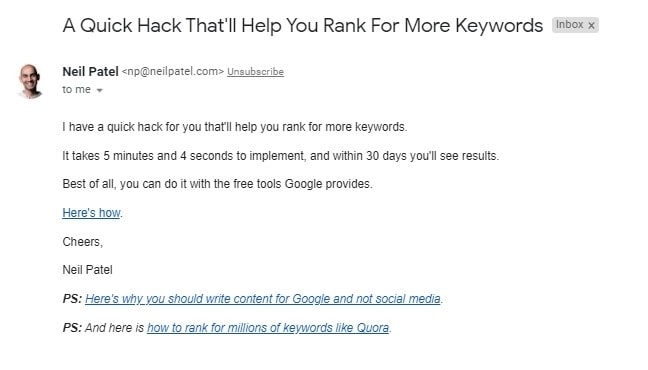
P/S stands for Postscript. It comes from the Latin word postscriptum, meaning “written after”. P/S is the chance to add an additional thought to the letter (and sometimes other documents) after it has been completed.
In the old age of handwritten and typed letters, P/S was really useful because we often found ourselves having something we wanted to add only after we finished writing. It was also often used to include an intelligent or witty thought. The P/S was the most charming part of the letter, like a wink you give as you say goodbye.
Although P/S once saved us from rewriting the entire letter just to add an important afterthought, nowadays, all emails allow users to go back and edit thoroughly before sending. Technically, P/S is not necessary anymore in electronic communication. Yet, P/S is still popular among many marketers and companies.
Back in 2016, Kate Goldstone quoted a statistics saying that 79% of recipients who opened a direct letter would read the P/S first. Times have changed, but marketers still rely on P/S as a way to reinforce a call to action, create FOMO, provide additional bonus or offer, and even share testimonials.
Let’s see why so many people love P/S and why you should have P/S in your emails.
Read more:
- How to Improve Email Click-through Rate
- What is Cost Per Acquisition?
- What is Performance Marketing?
Why should you have P/S in emails?
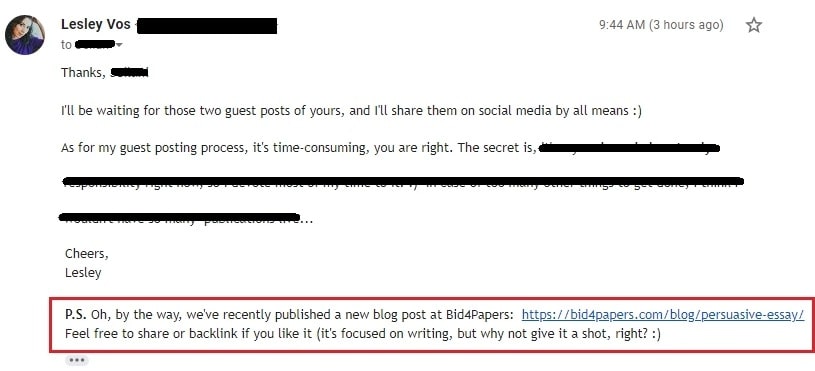
Although the Internet has given us a culture of surfers rather than readers of things like letter-to-word emails, we tend to notice what’s at the beginning and end of a document. Can you think of the time when you didn’t read PS in an email that you were interested enough to open?
Here are some of the reasons why every business owner and marketer should add a P/S to the emails.
A way to summary
Users view the P/S section as a short summary of what they’ll find in your marketing email. They scroll to P.S. to understand if it is worth the time. So if you are writing emails to offer discounts, previews, and other residual values to consumers, be sure to mention them in the P/S to get everyone’s immediate attention.
A visual advantage
In the digital world of shock and post-truth content, people get tired of the plagiarism and interpretations they find online. So they try to keep the email consumption to a minimum, scrolling rather than reading every word in search of useful information.
In fact, only 16% of users read your content word by word. Most just scan it, trying to pick main points; and also a visually appealing P/S in a text body is the second most readable paragraph of your email. Of course, after a headline. And you already know that users share content on social media without even surpassing the headlines.
A mean to create urgency
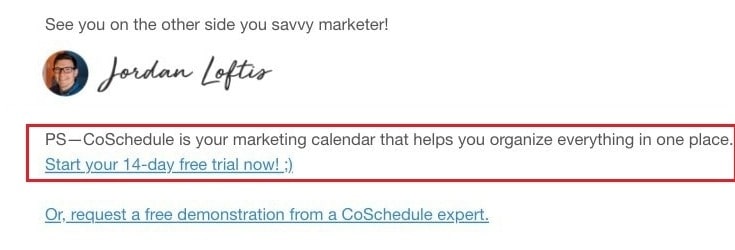
When you add P/S to the email copies and summarize what you’ve just written, you create a sense of urgency and make your email sound more convincing. A P/S allows the readers to give the appropriate attention to your message, clearly understand it, and are more likely to take action.
The urgency elements can be a deadline, the limited number of items available, or whatever you want the recipients to act. The urgency in the P/S section will undoubtedly improve your email performance.
A call to action
Have you heard of the Zeigarnik effect? That is when we feel uncomfortable if there are unfinished tasks and so try to complete them as soon as possible to relieve that stress. And that’s what happens to your email readers: they start reading your marketing email from P/S only to find a call to action that they want to fulfill.
So P/S in marketing emails can act as a CTA and invite readers to take the desired action. This trick will optimize the content of your email and affect your email click through rate. You can use the P/S section linking to your pitching videos, landing page, etc. Focus on the potential customer’s problem and the solution you can offer.
A channel for connection
Even if you don’t sell anything by emails, you can use P/S to encourage your audience to follow you elsewhere online. With some links to your social networking sites, readers can join your network or subscribe to your content channel (podcasts, videos, tips, etc.)
It’s a great way to grow your online audience and expand the network. For an even better customer experience, make sure that the P/S is visually appealing to engage with readers immediately. Use bold text, write in another font or color, format it as a separate info box, turn it into a button, and more.
An extra touch of personality
Marketing tactics and tricks aside, many people read P/S out of habit because of all the time reading real letters. Besides, how often do you read the last section of a newspaper first because it often contains the most entertaining content there? It’s like a delicious dessert: you know it will be the most satisfying part of the meal, so you want to try it first.
In your marketing emails, P/S is that dessert. And since it has a visual advantage and is something you might forget to mention in the email body, you can write anything you want. You can add a few thoughtful words that help communicate with recipients, or a funny thought that makes your emails stand out. People extremely appreciate humor from brands and will remember you more.
With all of the points above, you can see how adding P/S into your marketing emails is a great chance to improve the engagement and add a personal touch to the message. When you turn your emails into a real and thoughtful letter, readers will think the message was written specifically to them. Which is perfect to build customer loyalty and boost trust.
How to use P/S in email marketing?
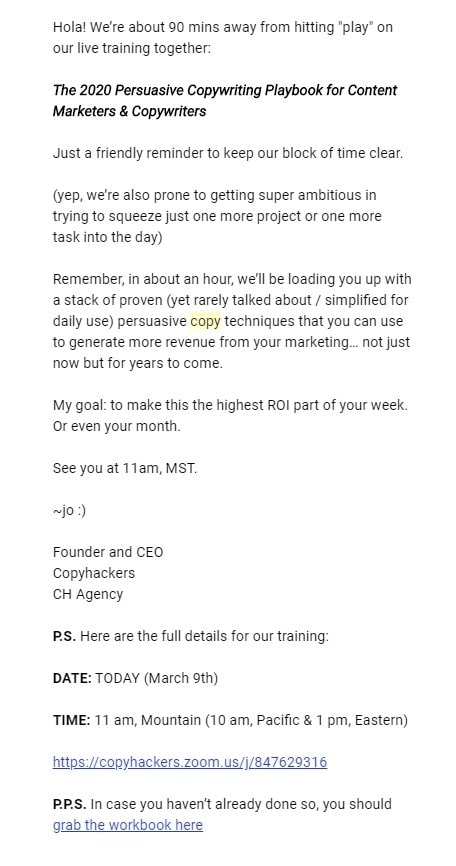
Now, with you knowing that P/S is a serious copywriting tactic to reinforce your marketing message and gain more value, it is time to see some proven ways of using P/S to enhance your marketing effort.
A trick is to incorporate lessons from the P/S into the body of your marketing email: recipients should be able to find answers to the questions they might have after reading every graph paragraph of your message. With that in mind, let’s see six useful tactics to use P/S in email marketing.
Personalize your P/S
A P/S is usually a part of how you personalize your emails - by signing off with the name of a real person in your company. The purpose of this approach is to make the email as personal as possible. This is almost exclusively for email recipients, so take advantage of that inherent benefit and say some more nice things in your P/S:
- Wish them well or a good day, saying the recipients’ name.
- Ask how their previous purchase was and ask for feedback.
- Address some relevant news to their locations.
- And more.
Provide bonus or a new offer
As P/S can act as a call to action, one of my favorite uses for them is introducing a bonus or a new offer. Throughout your email copy, you were selling the product or some other offers. Then in the P/S section, you tell them that they can get more if they act now. This adds a sense of urgency that not many can resist.
If you are sending newsletters, the same rules apply. You can showcase some products relevant to the information in the email, or you can tell users to create accounts and see even more exclusive deals. Add a little reminder and casually tell them how great your company can be.
Hook the recipients
A bonus is not always the best solution, so you can use P/S as a bait that is able to hook the audience. What often works best is to emphasize the main selling point again, but from a different angle. Why should you remind of your main selling point? Because there’s always the possibility of your readers scrolling down to the end of a message without looking closely through your glorious copy. If they’ve read it all through, then offering another important benefit that makes them want to bite.
For example, if you’re trying to emphasize the money-saving aspect of an offer, add something else like an extra emotion for a dramatic impact. Say how hard you try in the production phase to save cost, or that you would like to say thanks for subscribing.
Create urgency
The good thing about email is their instantaneous nature. You send them out and within a few days you know what your open and click rates are. The bad thing about emails is that they have almost no expiration date. So you want to make sure that you provide everything you have in the email to get readers to respond by visiting the landing page or contacting someone directly. Throughout your email, you’ve done your best to get them to act. P.S. Your is usually your last chance. Make it worthwhile.
Make a proposal for a donation
Adopting the tactic of putting a P/S at the end of the copy and making it a ‘Donate’ link can be a smart move for raising funds. It is never easy to ask for donations, but a well-crafted P/S can definitely be the deciding factor. If you are a small but passionate company, or a self-business, this is a must-try tactic. It is no shame asking for some donation so your company can keep delivering good products and services. You can pour emotion into the P/S or provide a bit of urgency.
Share a testimonial or a social proof
Not every product or service requires a testimonial. But in the case of products which buyers need a peace of mind before they commit to buying, testimonial or social proof is usually really effective. They provide a good review from previous purchasers or a third-party endorsement, which gives a sense of reassurance to the potential customers - maybe just enough to push them to the next step and put the items into the basket.
Examples of P/S in email marketing
John Morrow
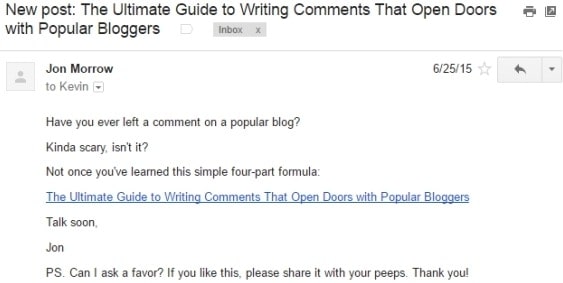
If your eCommerce business relies a lot on website traffic to generate sales, getting recipients to merely open the emails is only half the battle. You want them to actually click the link in your emails and start visiting your website. John Morrow took a ‘less is more’ approach to accomplish this task.
The subject line announced the publication of a new blog post, and readers can see a simple email with plain text inside. John offered a link to click with no images, no fluff, no distraction. He just wants readers to click the link. His P/S then asks the reader to share the information if they can.
The P/S works because if people found the blog useful, they would be more than willing to share it with their friends. It is also an easy-to-take action that anyone can do quickly.
CoSchedule

As mentioned above, the P/S in email marketing can act as a CTA to invite readers to take action. This trick can optimize your content and positively influence your email click-through rate. You can add a link to videos, social media accounts, sales pitches, landing pages, and more.
CoSchedule did exactly the trick in their P/S and provided not one, but two CTAs. The first asked the reader to start the 14-day free trial of CoSchedule, and the second shows another option to request a free demonstration from an expert. The company knew the prospect’s problems and provided the solutions for both situations in just the P/S section alone.
Neil Patel
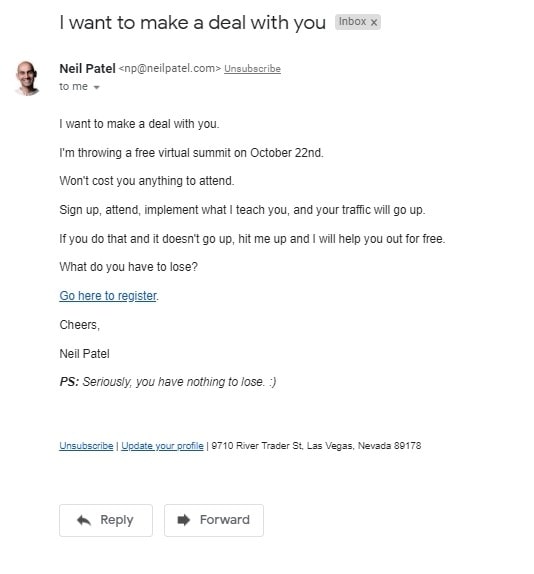
A company can always use the P/S in marketing emails to share a unique thought that can make the message memorable in the minds of the recipients. Just one little thing with a bold statement can turn potential customers into buyers and benefit your business down the road.
Neil Patel was promoting a new virtual summit in this email, so he really wanted to emphasize on the fact that it was free to attend. He already ended the copy with ‘what do you have to lose’, but decided to pack one more punch in the P/S with ‘Seriously, you have nothing to lose’. It reminded the readers that the event is free and even teased them a bit into taking action. Excellent!
Bonus: How to use P/S in business emails
As a bonus, P/S is often purposely used in business emails as a personal touch to call attention to the company’s ideas and promote the reader to take action. If you are a B2B business or simply want to contact with partners, this is the part for you.
The term ‘business emails’ can sound a bit unfamiliar since email is such a more casual method of communication than sending real letters. Therefore, you can always use P/S in business emails and it should have the same position as adding a P/S to a business letter.
With serious subject matter like legal or responding to a complaint letter, a P/S may not be appropriate. You will need to judge by yourself to see if P/S is a good fit or seems out of place. If you want a serious P/S, you can try writing like this:
P/S: I truly hope that we can help you solve this issue because we enjoy working with your company and would like to continue to do so.
For business emails, avoid rambling, emoticons, exclamation marks or question marks more than one, computer slang, and caps lock. If the email is important, try printing it on letterhead and try evaluating its professionalism.
Since the purpose of business emails is still to sell products or services, you should take advantage of the P/S to promote your offers too. What you need to remember the most about P/S in business emails is to keep professionalism and talk the way a company would expect to receive. Keep it short, straight to the point, and confident.
Related posts:
- How to Create an Email Marketing Campaign
- How To Build Your Email List Fastest?
- Email Marketing vs. SMS Marketing
- How to Create an Email Signature in Gmail?
My P/S
A long time has passed since we only use P/S to tell the words of ‘I love you’ like in a romantic movie. With the age of emails, however, the P/S can act as a perfect tool to boost trust, build more customer loyalty, and engage them with more sales. But don’t forget to send some love to your subscribers, they are still the endless source of prospects that you should pay attention to.
Here at AVADA, we have developed an app especially for email called AVADA Abandoned Cart Recovery - which you can use to sequence emails and segment the audience to reach them a personalized email and P/S that meet their needs. Start taking your email marketing to the next level so try the app now!
New Posts






